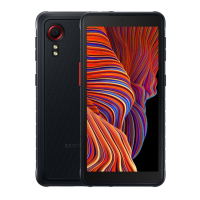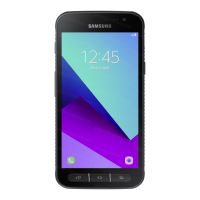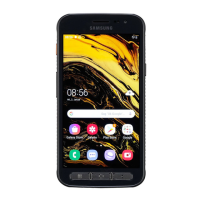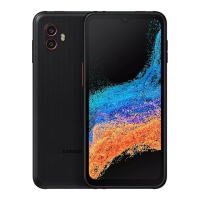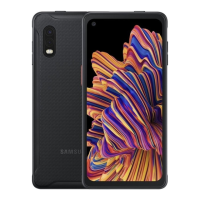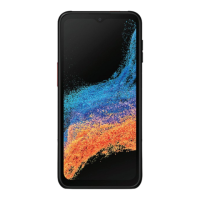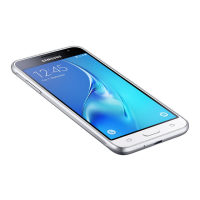Do you have a question about the Samsung Galaxy XCover FieldPro and is the answer not in the manual?
Device supports push-to-talk functionality.
Virtual assistant for personalized help and suggestions.
Capture high-quality pictures with ultrawide lens.
Use face or fingerprint to unlock device.
Expand storage with a supported microSD card.
Device is rated IP68 for dust and water resistance.
Identifies buttons and ports on the front of the device.
Identifies rear components like camera, flash, and scanner.
Instructions for inserting SIM card and battery.
Detailed steps for installing SIM, microSD, and battery.
Information on charging the device using the provided charger.
Basic steps to turn on, off, and restart the device.
Guides initial device setup, including language and network.
How to use Smart Switch to migrate data from another device.
Instructions on using the Power key to lock/unlock the device.
Guide to setting up and managing Google, Samsung, and email accounts.
Lightly touch items to select or launch them.
Lightly drag finger across screen to interact.
Touch and hold an item, then move it to a new location.
Use gestures to magnify content on the screen.
Touch and hold items to activate them or open menus.
Manage app icons on Home and Apps screens.
Organize app shortcuts into folders.
Change the look of Home and Lock screens.
Add widgets for quick access to info or apps.
Options to customize added widgets.
Customize layout, grid, icons, and notification panel.
Icons indicating battery, connectivity, and notifications.
Icons for missed calls, messages, and downloads.
Access device functions and settings quickly.
Display incoming notifications.
Unlock device using facial recognition.
Customize face recognition settings.
Use fingerprint for device and app authentication.
Add, delete, and rename fingerprints.
Use fingerprint for app/action verification.
Use two apps simultaneously in split screen view.
Configure split screen and pop-up view actions.
Access keyboard functions like clipboard and emojis.
Additional keyboard functions available.
Customize keyboard layout, languages, and typing.
Steps to enable emergency mode for power saving.
Available apps and features in emergency mode.
How to exit emergency mode and return to standard mode.
Overview of accessing and managing apps.
Remove or disable installed applications.
Find apps and settings using the search feature.
Organize app shortcuts alphabetically or by custom order.
Organize app shortcuts into folders.
Manage downloaded and preloaded apps.
Access and download premium content.
Download exclusive apps for Galaxy devices.
Create a private encrypted space for content.
Access support tools and exclusive content.
Make changes to created notes.
Options for sharing, deleting, or sorting notes.
View notes by category.
View past calculations.
Convert between measurements.
Add existing calendars to the app.
Add new events to the calendar.
Remove events from the calendar.
Learn to use camera interface, focus, and modes.
Instructions for recording high-quality videos.
Select and adjust camera shooting modes.
Configure rear and front camera settings.
Set and manage alarms.
Track time in multiple cities globally.
Convert times between different time zones.
Time events accurately.
Set countdown timers.
Modify contact information.
Initiate calls or messages from contacts.
Share content directly with contacts.
Mark contacts for easy access.
Send contact information to others.
Organize contacts into groups.
Compose and send email messages.
Organize and search email messages.
View emails from different accounts.
Modify email app settings.
Delete email accounts from the device.
Browse and view stored pictures.
Enhance pictures with editing tools.
Watch stored videos.
Trim, rotate, or add effects to videos.
Capture screen images.
Capture scrollable screens and edit.
Capture screenshots using a palm swipe gesture.
Use tabs to view multiple web pages.
Save and access frequently visited web pages.
Store web pages for offline access.
Review recently visited web pages.
Share web pages with contacts.
Locate messages using keywords.
Remove message threads.
Receive notifications for threats.
Send location and message in emergencies.
Configure text and multimedia message settings.
Organize files by recent, category, phone, or cloud.
Search, edit, and manage files.
Make and answer calls.
Initiate phone calls.
Call contacts by bringing device near ear.
Respond to incoming calls.
Reject incoming calls.
Terminate an active call.
Adjust volume, switch audio during calls.
Select audio output for calls.
Use other apps during an active call.
Set speed dials, block numbers, use voicemail.
View dialed, received, and missed calls.
Create or update contacts from call history.
Prevent specific numbers from calling.
Assign shortcut numbers for quick dialing.
Features like multi-party calls and Wi-Fi calling.
Make calls with multiple participants.
Make and receive video calls.
Make calls over Wi-Fi networks.
Browse the internet with Chrome.
Manage files in Google Drive cloud storage.
Make one-to-one video calls.
Send and receive email via Gmail.
Access Google search and personalized content.
Make payments using the phone.
Get directions and location-based information.
Store and back up photos and videos.
Watch movies and TV shows.
Play music and audio files.
Download apps, movies, music, and games.
Watch and upload YouTube videos.
Access online information for device questions.
Transfer data when switching phones.
View and manage voicemail messages.
Push-to-talk for first responders.
Ways to access device settings.
Find specific settings using search.
Manage network and device connections.
Connect to Wi-Fi networks.
Connect to networks not found in scan.
Configure Wi-Fi network and hotspot settings.
Share data between devices using Wi-Fi.
End Wi-Fi Direct connection.
Pair and manage Bluetooth devices.
Change the name of a paired Bluetooth device.
Remove a paired Bluetooth device.
Additional Bluetooth features.
Monitor mobile and Wi-Fi data consumption.
Reduce data consumption by limiting app usage.
Customize mobile data access and limits.
Restrict Wi-Fi data access and customize limits.
Disconnect all networks and turn off connectivity.
Use NFC for communication and payments.
Share data between NFC-enabled devices.
Make payments by touching the device to a reader.
Create a Wi-Fi network from your data plan.
Customize the hotspot password.
Control which devices can connect to the hotspot.
Customize hotspot security and connection.
Automatically turn off hotspot when not in use.
Share Wi-Fi network with other devices.
Share device's internet connection via USB.
Configure mobile network and data settings.
Manage location services and accuracy.
Select how location is determined (GPS, Wi-Fi, etc.).
Use Wi-Fi and Bluetooth scanning for better location.
View apps that requested location.
How location data is used by apps.
Connect to other devices easily.
Print documents and images from the device.
Mirror device display on car's infotainment system.
Connect to private secured networks.
Edit or delete VPN connections.
Establish a VPN connection.
Connect to a local network via Ethernet cable.
Control device sounds and vibration patterns.
Set device to Sound, Vibrate, or Mute.
Quickly mute sounds by covering the screen.
Customize vibration settings.
Adjust volume levels for ringtones and media.
Control media volume with volume keys.
Limit maximum output volume.
Set custom call ringtones.
Choose sounds for notification alerts.
Customize sounds for system actions.
Enhance audio quality with Dolby Atmos.
Customize audio presets.
Enhance sound resolution with headset.
Customize sound for individual ears.
Manage app alerts and notifications.
Configure app and service notifications.
Get vibrating alerts for missed calls/messages.
Configure screen settings like brightness and font.
Adjust screen brightness manually or automatically.
Reduce blue light for better sleep.
Adjust font size and screen zoom level.
Select screen quality modes.
Choose apps for full screen aspect ratio.
Add frames to icons for prominence.
Configure the LED indicator for notifications.
Set when the screen turns off.
Prevent unintended screen input.
Display colors or photos when screen is off.
Keep screen on while looking at it.
Adjust layout for one-handed use.
Adjust screen touch sensitivity.
View device status and optimize resources.
Improve performance by cleaning files and apps.
View battery usage and power saving options.
Manage device storage and memory cards.
Optimize device memory.
Manage microSD cards.
Connect memory card to device.
Unmount memory card before removal.
Prepare memory card for use.
Check available device memory.
Configure device language and keyboard settings.
Add or change the device language.
Select the default keyboard.
Use voice for text input.
Enable or disable on-screen keyboards.
Customize options for physical keyboards.
Use services for automatic text entry.
Configure speech output for accessibility.
Adjust pointer speed for external devices.
Set and manage device date and time.
Send diagnostic data to Samsung.
Resolve device issues and update software.
Check for and install device software updates.
Reset device settings or factory defaults.
Reset device to factory default settings.
Reset Wi-Fi, mobile data, and Bluetooth settings.
Schedule automatic device restarts.
Erase all device data to factory defaults.
Understand FRP security feature.
Activate FRP security.
Remove Google accounts to disable FRP.
Secure the device and protect data.
Choose from various screen lock methods.
Recommended methods for securing the device.
Configure Lock screen display elements.
Scan apps for security risks.
Locate, lock, and wipe device remotely.
Enable and configure Find My Mobile service.
Check for the latest security software updates.
Allow installation from unverified sources.
Use biometric data for services.
Create a private, encrypted folder.
Monitor app access to device features.
Require PIN/pattern/password on startup.
Protect SD card data with encryption.
Remove encryption from SD card data.
Set a password for factory resets.
Lock SIM card with a PIN.
Temporarily show password characters.
Automatically check for security updates.
Authorize apps for administrative access.
Manage security certificates.
Configure advanced security options.
Manage Google, Samsung, and email accounts.
Back up and restore data to Samsung Cloud.
Add email, social, and sharing accounts.
Configure sync settings for accounts.
Delete accounts from the device.
Back up and restore device data.
Enable backup to Samsung account.
Enable backup to Google account.
Back up data to SD card or USB.
Configure Google account settings.
Configure features for users with disabilities.
Adjust settings for visual assistance.
Adjust screen colors and contrast.
Adjust screen elements and create shortcuts.
Set screen to remain off for privacy.
Configure features for audial assistance.
Adjust audio quality for hearing aids/earphones.
Use visual alerts for notifications.
Configure features for limited dexterity.
Control device with alternative inputs.
Adjust screen sensitivity to touch.
Customize additional accessibility features.
Install additional assistance services.
Configure features for easier use.
View the user manual on the device.
Use two separate accounts for the same app.
View device information and software versions.
Access video tutorials and guides.
Interactive tool for learning device features.
Access helpful tips and guides.
Get support and assistance for your device.
Contact support via social media.
Information regarding AT&T service and policies.
Samsung's security platform for enterprise use.
Tips to preserve water and dust resistance.
Device passed MIL-STD-810G testing.
Safety guidelines for child use.
| Brand | Samsung |
|---|---|
| Model | Galaxy XCover FieldPro |
| Category | Cell Phone |
| Language | English |
